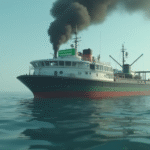Introduction to Ciudad Juárez’s Economy and the Maquiladora Industry
Ciudad Juárez, a bustling city in the Mexican state of Chihuahua, boasts a population of approximately 1.5 million residents, accounting for 40% of the state’s total population. With around 769,000 economically active individuals, 72% of them are formally employed. The primary source of employment in this border city is the maquiladora industry, which has been a cornerstone of Ciudad Juárez’s economy since the 1970s.
Historical Background of the Maquiladora Industry
The maquiladora industry in Ciudad Juárez began to flourish in the 1940s, driven by increased tourism, cross-border commerce, and migration. The industry’s growth was further propelled by influential entrepreneurs like Antonio J. Bermúdez, who established organizations aimed at promoting economic and social development in Mexico’s border regions. Since then, the maquiladora industry has become the backbone of Ciudad Juárez’s economy, with 330 manufacturing plants spread across 21 industrial parks within 13 industrial zones.
Challenges and Solutions in the Maquiladora Industry
With a high proportion of economically active residents and a growing job market, Ciudad Juárez faces challenges such as reducing employee turnover and absenteeism. According to the Maquiladora Association (INDEX), employee turnover has decreased from 4.2% in January to 2.6% in April 2025, while absenteeism dropped from 4.45% to 3.27% during the same period.
To tackle these issues, employers have implemented salary bonuses, increased benefits, and services such as subsidized or free meal provisions for workers. The International Labour Organization (ILO) supports this approach, stating that proper nutrition for workers enhances productivity, motivation, and reduces sick leave and absenteeism.
The Rise of Industrial Dining Facilities
In recent years, it has become common for maquiladora industries to outsource meal service providers to cater to their employees across shifts. This has led to the emergence and growth of businesses known as industrial dining facilities, which add value to agricultural products by processing and distributing them.
Industrial Dining Facilities in the Agro-Food Chain
Industrial dining facilities are part of the agro-food chain, responsible for processing, distribution, and commercialization of food from farm to consumer. Although they don’t engage in production, their role involves the final three stages: processing, distribution, and commercialization. These facilities require infrastructure, skilled personnel, equipment, transportation means, and working capital to ensure timely and efficient service for large numbers of workers—approximately 300,000 per day in Ciudad Juárez.
Supporting Industrial Dining Facilities in Ciudad Juárez
As FIRA (Financiera de Desarrollo Chiapas-Tapachula) representatives in Ciudad Juárez, we prioritize accrediting more industrial dining facilities to promote financial inclusion and boost their productivity through short-term credits for working capital and factoring, as well as long-term loans for construction, expansion, or modernization of facilities, processing areas, and refrigeration/freezer chambers. We also facilitate equipment and specialized transportation leasing.
Key Questions and Answers
- What is the primary source of employment in Ciudad Juárez? The maquiladora industry is the main employer in Ciudad Juárez, with 330 manufacturing plants across 21 industrial parks.
- Why is proper nutrition important for maquiladora workers? Proper nutrition enhances productivity, motivation, and reduces sick leave and absenteeism among workers.
- What role do industrial dining facilities play in the agro-food chain? Industrial dining facilities are responsible for processing, distribution, and commercialization of food products, adding value to agricultural inputs.
- How does FIRA support industrial dining facilities in Ciudad Juárez? FIRA accredits and finances these businesses through short-term credits for working capital and factoring, as well as long-term loans for facility improvements and equipment purchases.






